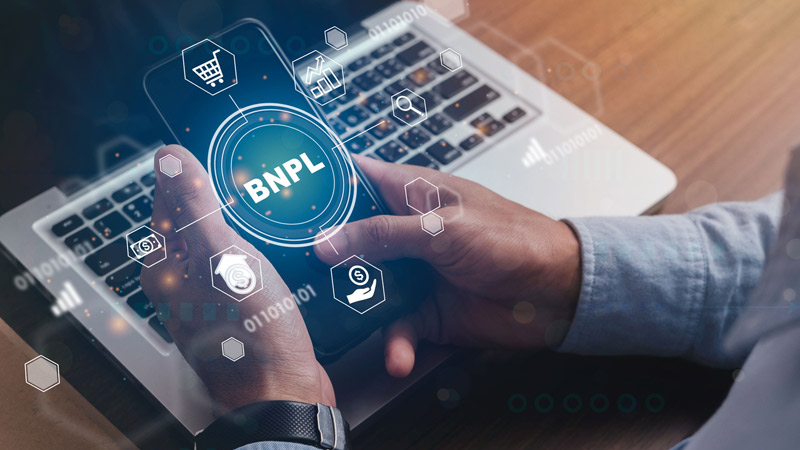BNPL May Change How You Sell — and How You Shop
Buy now, pay later (BNPL) is the big, transformative force in retail. In fact, Insider Intelligence estimates BNPL will account for $680 billion in sales in 2025 — up from $285 billion in 2018.

If you are an online retailer, you need to know about BNPL because your customers want it. Online shopping is where BNPL first took off, and now it is becoming an expected option at checkout.
BNPL is everywhere today — even luxury products. For example, says Jackie Mattia, director of financial services strategy at Movable Ink, Peloton owes a great deal of its quick success to its relationship with BNPL leader Affirm which offered many buyers 36 months to pay for their exercise machine. That brought the monthly cost to around $70, which is comparable to a high-end gym membership.
At a different price point is Goldbelly, where the Jacques Torres Valentine’s Day heart truffle box sells for $34.95. But just before checkout, a pop-up advertises “4 interest-free payments of $8.73 with Klarna.”
Why the recent ubiquity of BNPL? “Consumers want it,” says Sheridan Trent, research analyst at payment consulting firm The Strawhecker Group. “Retailers offer it because consumers are asking for it.”
Ted Roissman, a senior analyst at Bankrate.com, points a finger at particular consumers: “Many consumers – particularly young adults and people with lower credit scores – are drawn to buy now pay later services because these plans can be easier to qualify for than credit cards and they offer predictable payback periods that can be less costly.”
Roissman is right: BNPL funding decisions are not typically made on the basis of traditional credit scores. Every BNPL player has its own funding algorithm, but the decision hinges upon how much spare cash the consumer is likely to have. Can they handle a $40 per month payment for four months? If the answer is yes, the purchase gets the green light, even if the consumer is technically a subprime borrower.
As for BNPL being less costly, usually, it is. First of all, most BNPL is interest-free. Credit card purchases, on the other hand, can involve hefty interest charges.
Bankrate.com offers a case where a $5,000 purchase is put on a credit card with an 18.9% APR. The minimum payment amount is 4% of the principal and $200 to start. Pay only that, and it takes 11.4 years to pay off and total payments are $8,109. Pay off a BNPL contract on the agreed-upon schedule and what a consumer pays is what they agreed to in the first place.
How can BNPL be interest-free? Because BNPL players get discounts from the retailers. Different retailers negotiate different deals, but as Sheridan Trent notes, “I have seen 5% to 7% per transaction.” Sound like a lot? Trent further remarks that “a typical credit card transaction is 3%” — but if this is a sale that would be lost if it weren’t for BNPL, the few extra percentage points aren’t worth quibbling over for most retailers.
Then, too, BNPL buyers are believed to make bigger purchases than they would without it. According to Neeko Gardner, a principal in Oliver Wyman's payments practice, “BNPL can increase the average purchase amount by 40%-50%.” That makes BNPL worth the discount that is effectively given to the BNPL provider.
Now consider this: according to The Motley Fool, 55.8% of consumers have used BNPL — a growth rate of almost 50% in a year. And most experts say BNPL is in its beginning stages; much more growth is predicted.
The Rise of BNPL Startups
BNPL has become a big business in a short few years, but there still is abundant opportunity for startups in creating new BNPL tools.
There already are behemoth BNPL players — Affirm, Afterpay, Klarna, PayPal and Zip to name the biggest. PayPal, says The Motley Fool, has been used by 43% of BNPL users. But watch this space. Established, traditional credit card companies such as American Express have already moved in.
Where can startups get a foothold? By looking for niches that are presently ignored by the giants. One of the hottest BNPL trends now is a rise of offerings aimed squarely at small business owners who are buying supplies on a tight budget.
Case in point: BlueTape, a BNPL startup aimed at home improvement contractors. Co-founder and CEO Yaser Masoudnia explained that contractors often need to buy $5,000, possibly $10,000 or even more in supplies, from roofing shingles to kitchen floor and wall tiles. What BlueTape offers is a BNPL option that provides the contractor an interest-free period to pay for those supplies. The purchase must be made at a vendor that participates in BlueTape and agrees to offer a discounted price.
Masoudnia explains why he co-founded BlueTape: “I come from a construction background — I have experienced challenges in making payments to suppliers. I wanted to see if we can help.”
Other BNPL startups are looking at a different angle. At equipifi, co-founder and CEO Bryce Deeney says his focus is on building a BNPL platform that will be marketed to community banks and credit unions as their way to get a foothold in the BNPL market where, so far, they have been excluded. That’s an entirely different approach from the established BNPL players with their deals directly with merchants.
Equipifi’s plan is to sign up financial institutions, and then, when a bank customer has just made a qualifying purchase, a notification will pop up: do you want to handle this transaction as a buy now pay later purchase? That offer can be in the consumer’s hands in under a minute, Deeney says, who further notes there is no credit application. That offer is pre-approved.
As for how equipifi will validate a consumer’s financial stability, Deeney says the check does not involve credit history but does involve knowledge of the consumer’s monthly cash flow — which equipifi has access to at the participating financial institution.
In this BNPL variation, there are interest charges, but that is spelled out in the offer, Deeney says. Often, too, he explains, the APR will be lower than with a credit card.
There will be many more BNPL startups. Thinking differently will be the key to competing with the behemoths.
Bumps in the Road
What is the downside to BNPL? This question is getting asked in places that very much matter to the future of the industry, such as the Consumer Financial Protection Bureau (CFPB), a federal agency that has issued orders demanding information from leaders in BNPL about their funding decisions. A particular focus is on debt accumulation by cash-strapped consumers: giving too many BNPL deals to consumers with too little cash.
There also is brewing regulator anger about the scope of BNPL. There are providers that will offer BNPL on just about anything, and that is triggering loud regulator complaints in the United Kingdom.
But perhaps a more existential worry in the BNPL sector is that right now, there is no centralized database that tells which BNPL contracts a particular consumer has active. Apply for a $5,000 line of credit at a bank, and the bank pulls a credit report that will show exactly what obligations are outstanding.
No such database presently exists for BNPL, and, consequently, some financial institutions and merchants are wary about the future of BNPL.
But, a fix is in the works. According to Bryce Deeney, "BNPL providers, lenders, and credit bureaus are working together to create new databases to allow lenders the ability to have real-time visibility into BNPL installments. Up until now, there hasn't been a centralized way BNPL providers could submit this data without it impacting consumers' credit scores. equipifi is playing an active role in creating normalized BNPL data to be available at the bureaus and will also be available to the lenders we are partnered with. They will be able to use third-party BNPL data to have a more holistic view of their customers as they underwrite all consumer lending products."
One way or another, BNPL players will work out a way to quickly discover how many BNPL obligations a particular consumer has, and that will bring more order to the marketplace.
What’s the future of BNPL? “I see it continuing to expand,” says Jackie Mattia. Most experts think likewise. There are many consumers to whom it appeals, and, yes, there are also the many merchants who love the sound of a ringing cash register even if the arrival of the money is a little delayed.
About the Author

Robert McGarvey, a veteran journalist who has long covered startups and small businesses, created and hosts the CU2.0 Podcast for credit union and fintech executives which is at 120 episodes and counting.
Startup Resources
- Learn more about Startups
- Visit the TRUiC Business Name Generator
- Check out the TRUiC Logo Maker
- Read our Business Formation Services Review
- Find Startup Ideas
- Explore Business Resources
Form Your Startup
Ready to formally establish your startup? Click below to read our review of the best business formation services!
Best Business Formation Services